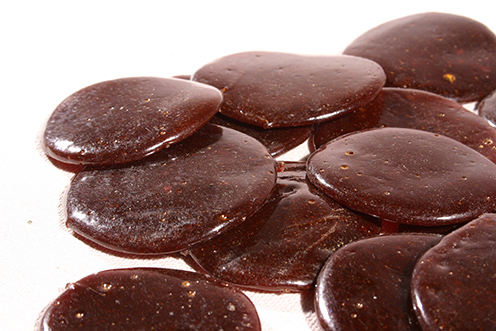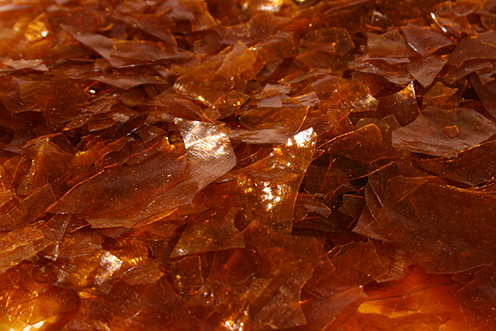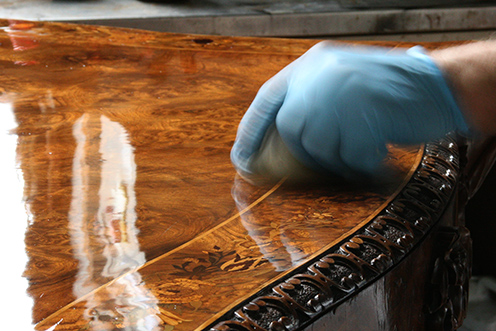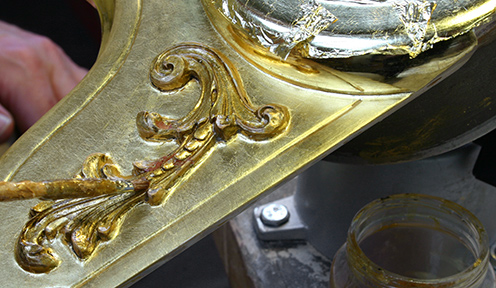By Bart Bjorneberg, Bernacki & Associates, Inc.
Shellac
Photo: French polished secretary
Shellac is an all purpose sealant and finish that is durable, time tested, and so non-toxic it is edible. It is environmentally friendly, renewable, and capable of incredibly deep rich finishes that are organically and aesthetically compatible with all woods. It can be used alone, with traditional natural finishes and coatings, and with modern synthetic mixtures.
Shellac consists of a resin which is the secretion of the female lac beetle and the solvent ethyl alcohol. The lac beetle (Laccifer Lacca) is found in southwest Asia, primarily India. The beetles feed on the tree sap of three specific trees: Palash, Kusum, and Ber or Indian Plum. During the life and egg lying cycles of the female beetle lac is secreted to protect the beetle and the eggs. The branches are then harvested and the lac resin scraped off. This is called sticklac and at this stage it is still very impure with a lot of contaminants and debris.
Additional filtering and washing removes most of the foreign debris and gives youseedlac. At this point the resin becomes a usable finish when dissolved in alcohol. The seedlac is then heated and filtered through cloth and deposited on to a cool metal surface in small discs which are called button lac.
Photo: Minimally processed rich red toned seedlac containing twig and lac beetle remnants
Photo: Deep dark (redish cast) amber buttons recommended for use on natural Cherry, light Mahogany, or on woods where a rich warm toned finish is desired
There are many resultant varieties of shellac. These variations are created by the type of tree initially involved, the area, the beetles, and the variations of filtering process which consists primarily of heat or bleaching. The different tree sources and variations of filtering and manufacture can give you a wide range of color from very pale and colorless to dark garnet. Another variation is whether or not the inherent natural wax is removed. The amount of wax can determine clarity and influence the hardness of the final film. If you are interested in further investigating the history and types of shellac harvesting and manufacture, there is a wonderful short film online. Click here to watch.
Photo: Blond shellac flakes
Photo: Red shellac flakes
There are many pre-mixed brands of shellac but unless you are very sure of the quality and purity of the ingredients used it is best to buy the shellac resin in dry form and mix it with ethyl alcohol yourself. Shellac is designated in term of cut, a one pound cut is one pound of shellac resin dissolved in one gallon of alcohol. Typical uses involve two or three pound cuts though shellac is easily varied by the addition of alcohol and can be used at various mixtures.
There is a great deal of confusion about the term shellac. It can be traced back to the Sanskrit word lakh (laksa) which means 100,000. This relates to the vast number of beetles needed to infest the trees in order to produce significant amount of resin. Shellac has been used in India, Southeast Asia, and China for many centuries. Written accounts go back 3,000 years but it was probably in use even earlier.
There is evidence and accounts of shellac being introduced to Europe as early as the thirteenth century. Its use became fairly widespread beginning in the seventeenth century. This was the result of the opening and expanding trade routes to the Far East due to the advancement of the shipping industry. At the same time there was expanding importation of exotic woods from both the Far East and the Americas. The increased prominence of exotic wood veneers such as mahogany and satin wood required a clear coating that would enhance and protect while not covering up the subtle colors and grain patterns. Shellac was perfect for this.
During the same period lacquer ware or urushi from China, Korea, and Japan was also introduced to the European market. At this time the process of producing a finish by applying urushial, the tree sap from the urushi trees was many centuries old in the Far East but not available in Europe. This was due to the process being a carefully guarded trade secret that is very labor intensive and difficult, requiring the application of many coats with carefully controlled setting times in a hot and very moist environment. Urushi also does not travel well. The look became very popular and the importation of true lacquer ware could not meet the demand.
The manufacture of imitation lacquer ware (Chinoiserie, japanning), became very profitable. Pigmented shellac became one of the key ingredients in creating an equivalent to urushi lacquer ware. Confusion arose due to the commonality of the names, shellac was often called just lac during this time, and the similarity of the appearance of the final finishes. But the two finishes are very different in origin, chemical makeup, and susceptibility to different conditions and solvents. True urushi lacquer is an extremely hard, water proof, heat resistant natural polymer that forms a hard non-reversible film through oxidation. Shellac is a natural bioadhesive polymer that hardens through evaporation and is susceptible to water, heat, and is reversible through the reintroduction of its main solvent alcohol.
From the mid eighteenth century to the early twentieth century in Europe and America shellac was considered the prime coating for fine furniture and woodwork. But shellac was also very popular as a wood sealant and coating and was used at any level when it was available. The ultimate expression of shellac finish is French polish.
French polish is the method of application rather than the material, though there are premixed usually high quality de-waxed shellacs that are sold as French polish.
In French polishing the shellac is applied with a cotton pad which consists of fad or cotton wadding wrapped inside a rubber which is typically a cotton cloth. The shellac is injected into the wadding and applied in thin coats by rubbing the rubber over the surface. The method is very labor intensive, requires drying between layers, is very tricky to master, and has about as many recipes, methods, and tricks as there are French polishers.
Photo: French polishing in progress
Photo: French polishing revealing high luster and depth of wood color
The final finish can be brought up to a closed grain, clear, mirror like finish that is wonderfully warm, deep, and complimentary to wood. While the finish is susceptible to damage from the exposure to moisture and heat it can be readly repaired by repadding with alcohol or additional shellac. This is very different from most synthetic catalyzed polymer coatings that are unworkable once they chemically crosslink.
Shellac was replaced in many uses in the 1920s and 1930s due to the popularization of nitrocellulose lacquer and later by the subsequent development of synthetic chemical spray finishes. These spray finishes have much greater short term durability due to their chemical cross linking which gives them greater resistance to moisture, heat, and impact. This increase in "strength" and chemical longevity is balanced by their irreversibility. This means they are very hard to repair. This means any damage that has to be repaired requires stripping. If the piece or construction is of a fine wood, this means you will lose any patina. As wood is always going to shrink and swell due to relative humidity changes, these finishes are susceptible to eventual cracking and the only treatment is total replacement through chemical stripping and refinishing. Shellac can be washed down with alcohol to whatever depth is needed to treat damaged or degraded areas. This allows repairs or new finish to be applied without damaging the wood substrate or patina.
Shellac is very useful as a sealant since it will stick to almost anything. While susceptible to moisture it is an extremely good barrier to moisture vapor and odors. Even when dry, it has a degree of plasticity that will allow some movement and reduce cracking. It is UV light resistant and does not react to most solvents other than alcohol.
My specialty is gilding and I use shellac in many ways. Shellac makes the best base for oil gilding. A shellac coating provides the ideal surface for the application and subsequent drying of the primarily boiled linseed oil sizing. It provides a completely non porous inert surface ideal for a film that dries through oxidation. A clear de-waxed shellac coating is then the perfect top coat after the gold leaf has been applied to the sizing. Its color and transparency go together very well with gold leaf.
Photo: Applying shellac base coat before oil gilding
Photo: Applying shellac top coat on oil gilt gold leaf surface
Many lacquers and catalyzed polymer finishes will react with the underlying sizing causing accentuation of the leaf lines or shrinkage that can mar the guilt finish. Once shellac has been applied over the gold leaf, additional coatings can safely be applied for added protection without problem. I have top coated shellac covered oil gilding with everything from nitro cellulose lacquer, to polyurethane, to synthetic resins such as B-72 in a variety of solvents.
Shellac has also traditionally been used as a top coating for water gilding, though I have found I get much better results and protection using a nitrocellulose lacquer (Agateen brand), especially over burnished leaf. If very yellow shellac is applied over silver or white gold leaf, the final effect will be as if gold leaf was used. Historically, many picture frames were done using this method when silver leaf was much cheaper and readily available.
Like all coatings, shellac has its pluses and minuses. There is no universally perfect finish. A finish must be chosen on the basis of the substrate or surface to be covered, the use the covered area is going to be subjected to, the environment that will surround that surface, and the desired appearance or aesthetic. If a surface is going to be exposed to a great deal of wear or impact, moisture, or heat, shellac is not recommended. But is you need an excellent sealant or unmatched final finish coating that is repairable, renewable, environmentally friendly, and has a proven track record thousands of years long, maybe you should try shellac.











